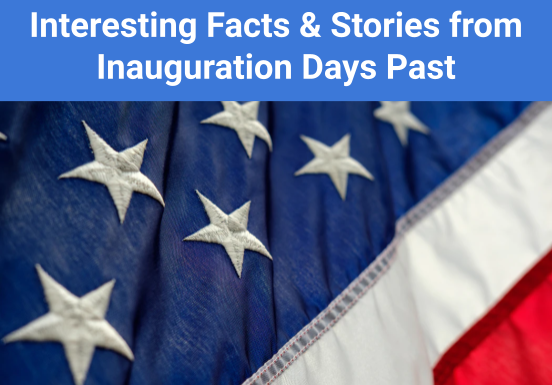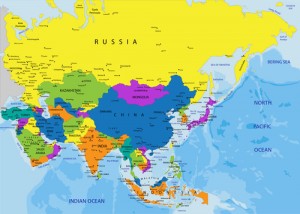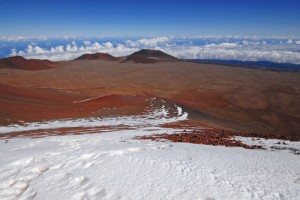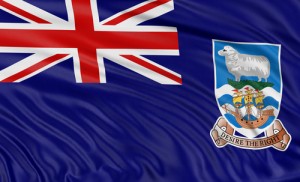Currently Browsing
Posts Tagged ‘ fun facts ’
Interesting Facts & Stories from Inauguration Days Past
- 6 January //
- Posted in Fun Facts //
- Tags : fun facts, ideas, teacher resources
- Comments Off on Interesting Facts & Stories from Inauguration Days Past

On Wednesday, January 20, 2021, at noon, President-elect Joe Biden will be inaugurated as the next president of the United States. Learn all about Inauguration Days from the past here!
Biden will be sworn into office as the 46th commander-in-chief. Inauguration Day is typically a day of pomp and circumstance, carefully planned out to reflect tradition and the orderly transfer of power. (This year’s activities will be limited due to the COVID-19 pandemic — see below). However, through the years there have been some moments that stand out as atypical of the normal routine. Here are some interesting facts and history from Inauguration Days past.
A Change in Date
For well over a century, the new president was sworn in on March 4. This extended lame-duck session led to numerous problems for incoming presidents, so the date of inauguration was established as January 20 by the passage of the 20th amendment to the U.S. Constitution.
A Change in Location
The first president who took the oath of office in the nation’s current capital of Washington D.C. was Thomas Jefferson in 1801. Previously, George Washington took his first oath in New York. His second oath, along with John Adams’ one and only, were administered in Philadelphia.
The Oath of Office
There have been numerous occasions when the oath of office had to be re-administered. The most recent and infamous example was in 2009. On that day, the oath was incorrectly read by Chief Justice John Roberts and repeated by President Barack Obama. Because the oath was not read and repeated exactly as stated in the Constitution, Obama and Roberts had a do-over “out of an abundance of caution”. The oath has been repeated six other times in history due to a variety of issues. Four presidents – Rutherford Hayes, Woodrow Wilson, Dwight Eisenhower, and Ronald Reagan – restated their oaths publicly because Inauguration Day took place on a Sunday, meaning only private ceremonies were held. Chester Arthur and Calvin Coolidge both took the oath privately following the sudden death of the sitting president, as did Lyndon Johnson in 1963 after the assassination of John F. Kennedy. Lyndon Johnson’s swearing-in is the only time a president has taken the oath while flying in an airplane.
The Inaugural Speech
The first inaugural speech was also the shortest (just 135 words). The longest speech is surrounded in intrigue as many believe it led to a tragic event. William Henry Harrison’s almost two hour, 8,500-word speech took place on a cold, wet day. In 1841, President William Henry Harrison chose to forgo a coat and hat, and rode on horseback instead of in a covered carriage. Many have attributed Harrison’s death from pneumonia just thirty days later to these poor choices, but modern historians dispute this theory. They instead point to poor handling of sewage in the area around the White House water supply that would have had devastating effects on Harrison’s gastrointestinal system.
Tragic results of Inauguration Day
There is, however, one death that is properly attributed to poor Inauguration Day weather. That sad designation belongs to Abigail Fillmore, wife of President Millard Fillmore, who, in 1853, remained at her husband’s side throughout his successor’s (Franklin Pierce) inauguration despite brutal wintry conditions. She developed pneumonia and died shortly after.
Coverage of the Inauguration
In 1845, James Polk’s inaugural was the first covered by telegraph. The first inauguration to be photographed was in 1857 when James Buchanan took the oath. William McKinley was the first president to have his inauguration filmed by a motion picture camera, and Harry Truman was the first to be televised. Bill Clinton’s second inauguration was the first to be live-streamed on the Internet.
Inaugural Balls
Every four years, much is made of the parties and inaugural balls. Fashion experts critique the outfits, gossip columnists cover the attendees, and pundits analyze the cost. The first inaugural ball celebrated the beginning of James Madison’s presidency in 1809. Tickets were just $4. In the 21st century, admission for two to the inaugural balls can cost upwards of $10,000!
The 2021 Inauguration’s Special Circumstances
Inauguration Day has a long list of traditional and customary practices that presidents and their staffs have followed for years. But nothing about the 2020 campaign and election season has been traditional. The COVID-19 pandemic will affect how this inauguration will be handled. Although a public ceremony is scheduled for January 20 at the U.S. Capitol, festivities will be limited to prevent the spread of the virus. The live audience will be limited to members of Congress. Public health measures such as mandatory face coverings, testing, temperature checks, and social distancing will be used for the ceremony.
Inaugural organizers are inviting communities around the United States to light buildings and ring church bells at 5:30 p.m. ET on the eve of the inauguration in a moment of “unity and remembrance” for those lost to the pandemic. A lighting ceremony at the Lincoln Memorial Reflecting Pool will be held simultaneously. Most traditional inaugural festivities will be conducted virtually. The parade, should it take place, will be historically limited, and other functions such as inaugural balls may not be held. The Biden Inaugural Committee has urged people not to physically gather in Washington for ceremonies.
You can sign up to receive details of the inauguration from the official Presidential Inauguration Committee 2021 website.
Resources for Teaching about Presidential Inaugurations
Free education resources
- The White House Historical Association offers free educational resources about inaugurations
- The National Education Association has some excellent activities for students of all ages
- The Anti-Defamation League offers 7 Ideas for Teaching about the Presidential Inauguration to middle and high school students
- The National Children’s Book and Literacy Alliance’s website “Our White House” has a free Presidential Inauguration Celebration Kit for Kids and many other educational resources for all ages
- A free lesson plan on inaugurations is available from the National Endowment for the Humanities
- The Library of Congress has lessons for the occasion
- C-SPAN has assembled free video-based inauguration materials for social studies teachers
Video Resources
C-SPAN has also compiled videos of inaugural speeches. Here are some of the more notable ones:
- Franklin Roosevelt’s first address, 1933 (“…the only thing we have to fear is fear itself…”)
- John F. Kennedy, 1961 (“Ask not what your country can do for you, but what you can do for your country.”)
- Ronald Reagan’s first address, 1981 (“Government is not the solution to our problem, government is the problem.”)
- Bill Clinton’s first inaugural ceremony, 1993 (which includes footage of Maya Angelou’s poem “On The Pulse Of Morning” written specifically for the occasion)
- Barack Obama’s first address, 2009 (“The nation cannot prosper long when it favors only the prosperous.”)
Activities and worksheets
- Help Teaching has created worksheets about the administrations of recent presidents
- KidsKonnect has a variety of worksheets related to the Presidents and their inauguration including a packet about the 20th Amendment which set the January 20th date for presidential inaugurations
Image source: Luke Michael on Unsplash
Everything Your Students Always Wanted to Know About Electing the President (But Were Too Afraid to Ask)

A lot goes into electing a president. The 24 hour news cycle has certainly improved the public consciousness about campaigning and each political party’s convention, but there is still much undiscovered territory for students, especially the role of the Electoral College in electing the 45th chief executive. As the 2020 presidential election nears, here are some terrific resources for teaching students of all ages how the next president will be chosen.
How did we get here?
Scholastic provides the “Road to the White House” that chronicles the journey from campaign to convention and through the election in an entertaining and illustrative interactive tour. Students of all ages will appreciate this journey as a refresher of how the United States narrowed a long list of candidates down to just two major party contenders in the last 12 months.
What are “blue and red states”?
When discussing an historical topic, teachers often rely on textbooks or handouts to explain common vocabulary terms in advance to avoid student confusion. But when discussing current events or “general knowledge” topics, we sometimes forgo a primer on the jargon necessary for understanding. Scholastic has provided a concise list of need to know terms as you discuss the electoral process to ensure no one is left behind when you reference “GOP” or a party’s “platform”.
What is the Electoral College?
Here is where your electoral adventure takes a turn toward surprise, and maybe even befuddlement. Many students may not know what the Electoral College is and why it determines the next president.
One way to explain this system is to use music. Musical Media for Education has a song about the Electoral College, which includes a lyrics list so your students can follow along with the song.
Or, if you’re old school like I am, Schoolhouse Rock has an excellent Electoral College song for use in your class ($) that covers the electoral system in their typical entertaining manner.
Does my vote even count?
Once your students understand the role of the Electoral College, they may wonder if their votes even count. Show them this Ted-Ed video about the electoral college and importance of voting, particularly in certain states.
Is this the best way to determine the leader of the free world?
This all may be a bit jarring for your students. They may have valid questions about whether this is the best, most democratic way to choose a leader. Go over the history of the Electoral College from the House of Representatives website. This History Channel video also gives more background on why the founding fathers implemented this system.
There are some detractors of this system. The major arguments are chronicled by Scholastic. This is a great opportunity to hold a debate or to ask students to write a claim about the validity of this system using a selection of documents from this post.
What do the electors do when they meet?
The meeting of the Electoral College is not a clandestine event. C-SPAN has video of the 2008 meeting of the electors from Illinois and Arizona. This is a terrific primary source that gives the students a glimpse into our democratic process.
How can a candidate win the election?
The best way to understand how an election is won is top ask the students to win an election themselves. iCivics has a fun election game to help students win the White House, as well as ideas for mock elections in the classroom.
Students can also track the race to 270 electoral votes with an interactive electoral map. This would also be handy for a research project that asks the students to predict the results of the election by tracking each state’s past voting habits.
The Washington Post has an Electoral College curriculum that encompasses all of the above questions in one handy document with numerous resources. In addition, Help Teaching offers numerous free election worksheets, including a presidential election quiz and electoral vote activities for both the 2008 and 2012 elections.
With so much attention paid to the popular vote and so much polling data on all of the major networks, it can be easy for students to be unfamiliar with the electoral process. Don’t let this election pass without giving them a primer on one of the most important components of our democratic system!
10 More Fun Facts for Geography Awareness Week
- 10 November //
- Posted in Fun Facts //
- Tags : fun facts, geography, social studies
- Comments Off on 10 More Fun Facts for Geography Awareness Week

It’s that time of year again! That’s right, it’s Geography Awareness Week. The time of year when students clamor for scintillating information about our world and features that make it special. You’ve probably read our first feature, Ten Fun Facts for Geography Awareness Week, and you’ve been waiting for a brand new installment to share with your friends. Well, your wait is finally over. Get a load of these fresh facts about our world.
- The wettest city in America (that is, the city with the most annual rainfall) is Mobile, AL, with an average of 67 inches. The notoriously rainy Pacific Northwest does not appear until 24th on the wettest list, but Olympia, WA is credited with having the most rainy days in the country, averaging 63 per year. The wettest inhabited city in the world is Buenaventira, Colombia, which receives 267” of rain per year!
- Africa is the only continent located in all four hemispheres. It is, therefore, the only continent to have land on the prime meridian and the equator.
- Alaska is clearly the northernmost and westernmost US state, but it’s also the easternmost! The Alaskan Aleutian Islands just barely cross the 180 degree meridian of longitude, placing them in the Eastern Hemisphere.
- China shares its international borders with an incredible 16 nations!

Well, some will argue that it is only 14 bordering nations. China attains its title of Border Nations King only when you include Hong Kong and Macau, “Special Administrative Regions” of China that are not exactly autonomous. If you do not count those two regions as independent nations that border China (and many in Hong Kong do not feel independent), then Russia ties China, as they also have 14 bordering nations. - The largest pyramid in the world is located in…Mexico! The Great Pyramid of Cholula is located in Cholula, Puebla, Mexico and was believed to be dedicated to the god Quetzalcoatl.
- We typically think of deserts as sand covered, barren areas with ridiculously high temperatures. But a desert is actually defined by its (lack of) rainfall amounts. The largest desert on Earth is the Antarctic Desert at 5.5 million square miles. This region averages less than two inches of rainfall per year. The largest hot desert in the world is the Sahara Desert at 3.1 million square miles.
- According to the most recent US census, 192 different languages are spoken in New York City, making it the most linguistically diverse city in the country. New York barely beat out Los Angeles, who came in at 185 languages. The title of most languages spoken in one country belongs to Papua New Guinea with 820! The island has been inhabited for 40,000 years, so many languages have evolved and differentiated themselves from other. Also, Papua New Guinea has many natural barriers, leaving its people very fragmented. Cultural diffusion is minimal and many of these tiny groups have retained their own languages.
- Mount Everest is the world’s tallest mountain…when measured above sea level. When measured from the sea floor, Mauna Kea in Hawaii measures at over 32,000 feet, making it over 3,000 feet higher than Everest. Mauna Kea is less than 14,000 feet high when measured from above sea level.

- The Falkland Islands house 500,000 sheep and only 3,000 people. There are numerous countries whose sheep population outnumbers the human population including New Zealand,Mongolia, and Australia.

- If you don’t like your neighbors, move to Mongolia. It is the least densely populated country in the world with four people per square mile. Monaco is the most densely populated country in the world at 49,236 people per square mile. Though, some would argue that Monaco’s reign as most densely populated country is unfair. The nebulous nature of the aforementioned Macau puts Monaco’s title in danger, as the “Special Administrative Region” of China has a population density of 55,301 per square mile.
Leave any fun geography facts that you discover in the comments section. We’ll be sure to have our third annual Geography Extravaganza next year.
16 Fun Facts about the 2016 Summer Olympics for Kids
- 25 July //
- Posted in Fun Facts //
- Tags : fun facts, sports
- Comments Off on 16 Fun Facts about the 2016 Summer Olympics for Kids

Every four years, athletes from around the world gather to compete in the Summer Olympic Games. While the athletes are competing to win gold, the games give kids a chance to learn more about the events the athletes are competing in, as well as the part of the world where the games are held. This year, the 2016 Summer Olympic Games are being held in Rio de Janeiro, the second most populous municipality in Brazil. Despite the controversy surrounding the games and their location, there are a lot of reasons to get excited. We’ve rounded up some fun facts about the 2016 Summer Olympic Games to help get kids excited too.
1. Rio de Janeiro is the first South American city to host the Olympic Games. For a fun geography activity, look up the locations of previous Olympic games and mark them on a world map.
2. Over 10,000 athletes will compete in the games. The U.S. will bring over 500 of those athletes, which you can learn about on Team USA’s website.
3. It will cost Rio de Janeiro over $9.5 billion to host the Summer Olympic games.
4. Golf will be played at the 2016 Olympics. The sport has not been part of the Summer Games for over 100 years.
5. In many countries, the competition just to make the Olympic team was tough. Queen Harrison, a hurdler, missed qualifying for the U.S. team by two one-hundredths of a second.
6. Over 45% of the athletes in Rio will be female. That’s a higher percentage of females than ever before.
7. Dipa Karmakar will compete as the first Indian female gymnast in 52 years to qualify for the Olympic games.
8. Yusra Mardini, an 18-year-old swimmer, will compete under the Olympic flag as part of the first team of refugee athletes.
9. Leila, Liina, and Lily Luik will be the first set of triplets to compete in the same Olympic sport. They are marathon runners from Estonia.
10. Simone Biles, the most decorated female gymnast in history, is the shortest member of Team USA at 4’8″ tall.
11. To prepare for the Olympics, workers in Rio de Janeiro built 43 miles of new roads and planted thousands of trees.
12. Canadian horse-jumper, Ian Miller, will compete in his 11th Olympic Games. He’s 69 years old.
13. Michael Phelps, the most-decorated Olympian of all time, will attempt to increase his medal count at the 2016 Games. He currently has 22 Olympic medals, 18 of them gold.
14. The country of Kosovo will compete in its first Olympics this year, sending eight athletes to the Games.
15. Nino Salukvadze and Tsotne Machavariani, shooters from the country of Georgia, are the first mother-son duo to compete at the Games.
16. Singer Katy Perry released her first single in two years, a song called “Rise,” which will be used as an anthem for the Olympic Games.
Want to learn more about the Olympics? Work with your kids to complete our Summer Olympics Scavenger Hunt or one of our other Olympics-themed worksheets found on our seasonal worksheets page.


